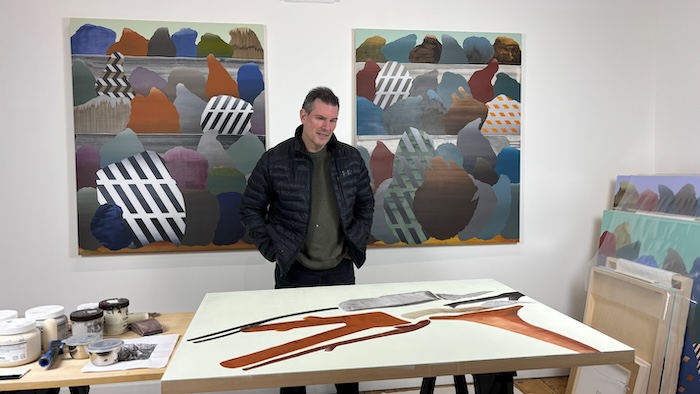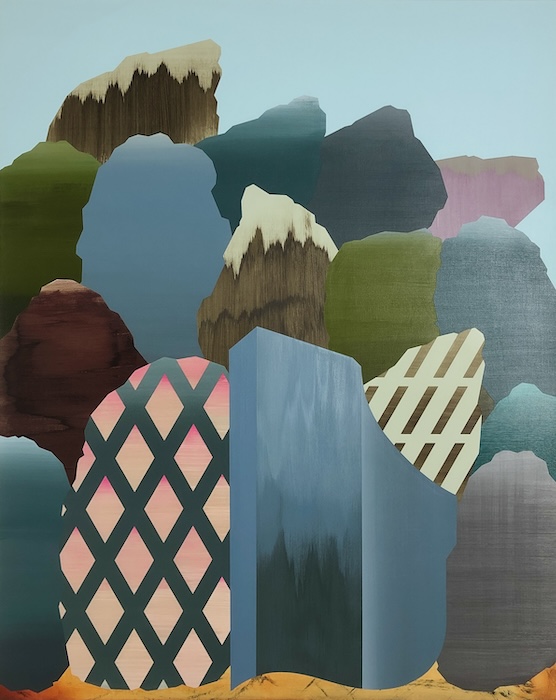Show features paintings by ‘archaeo-nerd’
Greg Slick’s studio in Newburgh is an interesting place. With a treetop view of brick apartments and Victorian-era homes, the former carriage repair shop dates to the 1870s.
A pulley system with a 4-foot-diameter gear, a larger flywheel and steel rope wound around a cylinder peeks over a wall in the modest space. “I am inspired by that,” says Slick, a New Jersey native who has lived in Beacon since 2003.
Two umbrella lights, typically used for photo shoots, flank his desk. Slick is “partially sighted,” he says. “With a little help, the brain is remarkably good at adapting to challenging conditions.”
Slick crafts what he calls “weird little” sculptures, but his current approach is painting with acrylic on wood, a technique informed by an obsession with the late Neolithic era about 5,500 years ago, when humans settled into farming.

Evidence of his armchair archaeological studies is reflected in Depth Perception, a solo show at the Garrison Art Center that opens Saturday (Feb. 8). In the adjoining gallery, a group exhibit, Home is Where the Heart Is, features work by Amy Cheng, Erik Schoonebeck and Zac Skinner, who lives in Beacon.
Though Stonehenge is the most famous monument, Neolithic societies arranged rocks and created elaborate structures with significant care and skill at thousands of sites across Europe and elsewhere.
Slick considers himself an “archaeo-nerd.” In his studio, he flips through The Old Stones: A Field Guide to the Megalithic Sites of Britain and Ireland, a thick, illustrated listing of more than 1,000 places. Two copies of The Proceedings of the Prehistoric Society, an academic journal published by Cambridge University Press, sit on another table.
“I joined the society so I could get the journal,” says Slick, who has visited several ancient architectural constructs and is the chief docent at the Magazzino Italian Art museum in Philipstown.
The new show’s title is apt because Slick’s striated series has evolved to feature what resembles layers of rocks beneath the Earth’s surface. Early iterations consist of piles of abstract stones (or scoops of ice cream).
The work developed into what he calls “stratigraphic, research-based” pictures with three layers separated by a stone-like wash created by dragging and dabbing a brush roller across the surface with his hands.
Up close and from the side, the works look like collages, with textured surfaces. Covering a stone with grids or a chevron breaks up the colors and evokes shamanistic and hallucinogenic rituals from prehistoric times, he says.
Some of the featured shapes are textured and scratched, while others are rendered with flat surfaces and brighter colors, like red and blue. At the bottom, a layer of what seems like dark yellow goo suggests magma.
“If you dig down far enough in the Earth, you’ll find a wall, a pot, a skull,” Slick says. “All this materiality connects us to the past. It’s the history underneath our feet and a bridge to 5,000 years ago.”
The Garrison Art Center is located at 23 Garrison’s Landing. The exhibits open with a reception from 3 to 5 p.m. on Feb. 8 and continue through March 9. An artist’s talk is scheduled for March 1. For more of Slick’s artwork, see gregslick.com.




After reading this article, with all its vibrant description and detail, I feel like I have just visited Greg Slick’s studio. I love learning about the artist’s thoughts and inspirations as he creates his colorful tableaux. Also, the photos with the article were well-composed and added so much interest.